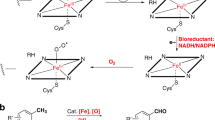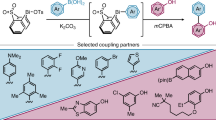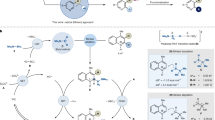Abstract
The partial reduction of electron-deficient pyrroles using either Birch (Li/NH3) or ammonia-free (Li/di-tert-butyl biphenyl) conditions allows formation of pyrroline compounds in good yield and, when combined with a reductive alkylation or similar approach, leads to highly functionalized, synthetically useful compounds. This methodology has been proven in the syntheses of several complex natural products, all of which show interesting biological activity. This protocol describes in detail the following stages of the partial reduction procedure: formation of the reducing solution, partial reduction of the pyrrole compound and finally quench of the resulting anion/dianion using either protonating agents or an aldehyde. The ammonia-free conditions described herein are particularly useful for reactions requiring the use of reactive electrophiles, such as acid chlorides or enolizable aldehydes, which are incompatible with the standard Birch reduction conditions. The reaction procedure for the ammonia Birch reduction (procedure A) takes about 9.5 h to complete. Those described for the ammonia-free reductions, procedure B and procedure C, can be expected to take approximately 33 and 8 h, respectively.
This is a preview of subscription content, access via your institution
Access options
Subscribe to this journal
Receive 12 print issues and online access
$259.00 per year
only $21.58 per issue
Buy this article
- Purchase on Springer Link
- Instant access to full article PDF
Prices may be subject to local taxes which are calculated during checkout







Similar content being viewed by others
References
Donohoe, T.J. & House, D. Ammonia free reduction of aromatic compounds using lithium di-tert-butylbiphenyl (LiDBB). J. Org. Chem. 67, 5015–5018 (2002).
Donohoe, T.J., Guyo, P.M., Harji, R.R. & Cousins, R.P.C. The Birch reduction of 3-substituted pyrroles. Tetrahedron Lett. 39, 3075–3078 (1998).
Donohoe, T.J., Guyo, P.M. & Helliwell, M. The stereoselective Birch reduction of pyrroles. Tetrahedron Lett. 40, 435–438 (1999).
Donohoe, T.J., Helliwell, M., Stevenson, C.A. & Ladduwahetty, T. Stereoselectivity in the Birch reduction of 2-furoic acid derivatives. Tetrahedron Lett. 39, 3071–3074 (1998).
Donohoe, T.J., Guillermin, J.-B., Frampton, C. & Walters, D.S. The synthesis of (+)-nemorensic acid. Chem. Commun. 465–466 (2000).
Donohoe, T.J., Mace, L.H., Helliwell, M. & Ichihara, O. Transformations of 3,4-disubstituted pyridines under dissolving metal conditions-partial reduction followed by radical cyclisation. Synlett 331–333 (2002).
Donohoe, T.J., McRiner, A.J. & Sheldrake, P. Partial reduction of electron deficient pyridines. Org. Lett. 2, 3861–3863 (2000).
Donohoe, T.J., Johnson, D.J., Mace, L.H., Bamford, M.J. & Ichihara, O. Partial reduction of pyridinium salts as a versatile route to dihydropyridones. Org. Lett. 7, 435–437 (2005).
Donohoe, T.J. & Guyo, P.M. Birch reduction of electron-deficient pyrroles. J. Org. Chem. 61, 7664–7665 (1996).
Donohoe, T.J., House, D. & Ace, K.W. Scope of the reductive aldol reaction: application to aromatic carbocycles and heterocycles. Org. Biomol. Chem. 1, 3749–3757 (2003).
Donohoe, T.J. & House, D. Diastereoselective reductive aldol reactions of Boc-protected electron deficient pyrroles. Tetrahedron Lett. 44, 1095–1098 (2003).
Carbery, D.R. & Donohoe, T.J. Enantiopure oxazolidinones as chiral acids in the asymmetric protonation of N-Boc pyrrole derived enolates. Chem. Commun. 722–723 (2004).
Donohoe, T.J. et al. Enantioselective partial reduction of 2,5-disubstituted pyrroles via a chiral protonation approach. Org. Lett. 6, 3055–3058 (2004).
Donohoe, T.J., Headley, C.E., Cousins, R.P.C. & Cowley, A. Flexibility in the partial reduction of 2,5-disubstituted pyrroles: application to the synthesis of DMDP. Org. Lett. 5, 999–1002 (2003).
Donohoe, T.J. & Thomas, R.E. Formation of N-Boc pyrrole 2,5-methyl diester, a key intermediate in the Donohoe synthesis of 1-epiaustraline and hyacinthacine A1 . Nat. Protoc. DOI: 10.1038/nprot.2007.232 (2007).
Donohoe, T.J. et al. Utility of the ammonia-free Birch reduction of electron-deficient pyrroles: total synthesis of the 20S proteasome inhibitor, clasto-lactacystin β-lactone. Chem. Eur. J. 11, 4227–4238 (2005).
Donohoe, T.J. & Thomas, R.E. Formation of N-Boc pyrrole 2-ethyl ester, a key intermediate in the Donohoe synthesis of omuralide. Nat. Protoc. DOI: 10.1038/nprot.2007.231 (2007).
Donohoe, T.J. & Sintim, H.O. A concise total synthesis of (±)-1-epiaustraline. Org. Lett. 6, 2003–2006 (2004).
Donohoe, T.J., Sintim, H.O. & Hollinshead, J. A noncarbohydrate based approach to polyhydroxylated pyrrolidizines: total syntheses of the natural products hyacinthacine A1 and 1-epiaustraline. J. Org. Chem. 70, 7297–7304 (2005).
Donohoe, T.J., Sintim, H.O., Sisangia, L. & Harling, J.D. An efficient synthesis of lactacystin β-lactone. Angew. Chem. Int. Ed. 43, 2293–2296 (2004).
Curtis, M.D. & Allred, A.L. Electron spin resonance spectra of some group IV-B substituted biphenyl anion radicals. Dative π-bonding. J. Am. Chem. Soc. 87, 2554–2563 (1965).
Rieke, R.D., Bales, S.E., Hudnall, P.M., Burns, T.P., Poindexter, G.S. Highly reactive magnesium for the preparation of Grignard reagents: 1-norbornanecarboxylic acid. Org. Synth. Coll. Vol. 6, 845–851 (1988); 59, 85–91 (1979).
Pangborn, A.B., Giardello, M.A., Grubbs, R.H., Rosen, R.K. & Timmers, F.J. Safe and convenient procedure for solvent purification. Organometallics 15, 1518–1520 (1996).
Author information
Authors and Affiliations
Corresponding author
Ethics declarations
Competing interests
The authors declare no competing financial interests.
Rights and permissions
About this article
Cite this article
Donohoe, T., Thomas, R. The partial reduction of electron-deficient pyrroles: procedures describing both Birch (Li/NH3) and ammonia-free (Li/DBB) conditions. Nat Protoc 2, 1888–1895 (2007). https://doi.org/10.1038/nprot.2007.245
Published:
Issue Date:
DOI: https://doi.org/10.1038/nprot.2007.245
This article is cited by
-
Mild and metal-free Birch-type hydrogenation of (hetero)arenes with boron carbonitride in water
Nature Catalysis (2022)
-
Arene dearomatization through a catalytic N-centered radical cascade reaction
Nature Communications (2020)
Comments
By submitting a comment you agree to abide by our Terms and Community Guidelines. If you find something abusive or that does not comply with our terms or guidelines please flag it as inappropriate.



